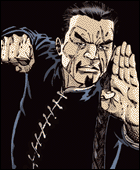

Hmong's
Kung Fu


This picture is the other type of kung fu call The
Drunken Fist.
It is also use in back in 1893 where the Hmong's fought against the Chinese's
kung fu.
The Story of Hmong's Life
Back in 1854 the Chinese wanted all of South China but there where these people
called Hmong living in South China.
Approximately 5000
years ago, the ancestors of the Hmong lived along the lower reaches of the
Yellow River in China. Wars and persecution from other ethnic groups forced the
Hmong to flee their homelands southward to Indochina. They apparently left China
at the end of the 19th century to settle near the tops of mountains in
Indochina: Laos, Thailand, Burma, and Vietnam. After the
destruction of San-Miao, the Hmong continued to migrate southward into today's
Hubei, Hunan and Jiangxi provinces. Much was talked about their living in the
Donating Lake and Poyang Lake areas, where the Chu Kingdom during the Eastern
Zhou and Qin Dynasties encompassed. Many scholars, both Hmong and non-Hmong,
argue that the state of Chu was a Hmong kingdom. If it was not Hmong, it
certainly was not Chinese. Conrad Scherzo Kauri, a published scholar of Chinese
history, referred to the Chu state as a "semi-Chinese." Many researchers,
including our Xiangtan professors, argue that the intact female corpse (died and
buried during the Chu Kingdom and excavated from a highly elaborate tomb in 1972
in Changsha, Hunan) was Hmong because the drawings on her caskets and on the
piece of silk covering her coffin are designs unique to the Hmong. Based on the seal
unearthed, this female corpse was named Xing Zhou, the wife of Li Clang who was
the Marquis of Dai. Even after more than two thousand years, her body was well
preserved and protected from decay by a set of four coffins carefully arranged
inside one another.
You are the
![]() visitor
to this site.
visitor
to this site.